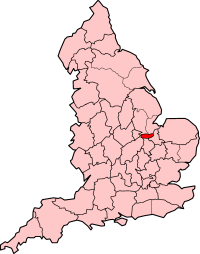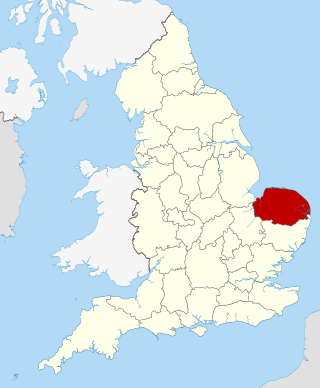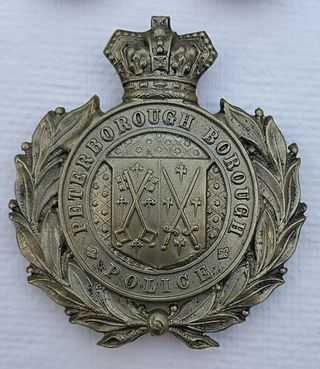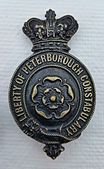
Cambridgeshire is a ceremonial county in the East of England and East Anglia. It is bordered by Lincolnshire to the north, Norfolk to the north-east, Suffolk to the east, Essex and Hertfordshire to the south, and Bedfordshire and Northamptonshire to the west. The largest settlement is the city of Peterborough, and the city of Cambridge is the county town.

The City of Peterborough, commonly known as Peterborough, is a unitary authority district with city status in the ceremonial county of Cambridgeshire, England. The area is named after its largest settlement, Peterborough but also covers a wider area of outlying villages and hamlets.

The Soke of Peterborough is a historic area of England associated with the City and Diocese of Peterborough, but considered part of Northamptonshire. The Soke was also described as the Liberty of Peterborough, or Nassaburgh hundred, and comprised, besides Peterborough, about thirty parishes.

Huntingdon and Peterborough was a short-lived administrative and geographical county in East Anglia in the United Kingdom. It existed from 1965 to 1974, when it became part of Cambridgeshire.

Cambridgeshire and Isle of Ely was, from 1965 to 1974, an administrative and geographical county in East Anglia in the United Kingdom. In 1974 it became part of an enlarged Cambridgeshire.

Cambridgeshire Constabulary is the local territorial police force that covers the county of Cambridgeshire and Peterborough unitary authority. It provides law enforcement and security for an area of 1,311 square miles (3,400 km2) and population of 856,000 people, in a predominantly rural county. The force of Cambridgeshire includes the cities of Cambridge, Ely and Peterborough, the market towns of Chatteris, Huntingdon, March, Ramsey, St Ives, St Neots, Whittlesey, and town and Port of Wisbech. Its emblem is a crowned Brunswick star containing the heraldic badge of Cambridgeshire County Council.

Stanground is a residential area of Peterborough, in the ceremonial county of Cambridgeshire, England. For electoral purposes, it comprises the Stanground South and Fletton & Stanground wards in the North West Cambridgeshire constituency.

Norfolk Constabulary is the territorial police force responsible for policing Norfolk in East Anglia, England. The force serves a population of 908,000 in a mostly rural area of 2,079 square miles (5,380 km2), including 90 miles (140 km) of coastline and 16 rivers, including the Broads National Park. Headquartered in Wymondham, Norfolk is responsible for the City of Norwich, along with King's Lynn, Great Yarmouth and Thetford. As of March 2023, the force has a strength of 1,897 police officers, 163 special constables, 1,318 police staff/designated officers, and 103 police support volunteers. The chief constable is currently Paul Sanford, and the police and crime commissioner is Giles Orpen-Smellie (Conservative).

The Mid-Anglia Constabulary was the territorial police force responsible for law enforcement in part of the East of England, from 1965 to 1974. It was created from the amalgamation of five forces. It was renamed Cambridgeshire Constabulary in 1974.

Peterborough City Council is the local authority for Peterborough in the East of England. It is a unitary authority, having the powers of a non-metropolitan county and district council combined. The City was incorporated as a municipal borough in 1874; from 1888, it fell within the jurisdiction of the Soke of Peterborough county council and from 1965, Huntingdon and Peterborough county council. In 1974, it was replaced by a wholly new non-metropolitan district, broadly corresponding to the Soke, in the new enlarged Cambridgeshire. In 1998, Peterborough became independent of Cambridgeshire as a unitary authority, but the city continues to form part of that county for ceremonial purposes as defined by the Lieutenancies Act 1997.

The Police Act 1964 (c.48) was an act of the Parliament of the United Kingdom that updated the legislation governing police forces in England and Wales, constituted new police authorities, gave the Home Secretary new powers to supervise local constabularies, and allowed for the amalgamation of existing forces into more efficient units.

The Police Act 1946 was an Act of Parliament of the Parliament of the United Kingdom that provided for the amalgamation of smaller borough police forces with county constabularies in England and Wales, allowed for the merger of county forces in certain circumstances and changed the boundaries of the Metropolitan Police District.

The Ross and Sutherland Constabulary was a Police Force in Scotland that existed between 16 May 1963 and 16 May 1975. Kenneth Ross, BL was the Chief Constable of the force for its entire existence.

Buckinghamshire Constabulary was the Home Office police force for the county of Buckinghamshire, England, until 1968.
Cambridge City Police was the territorial police force responsible for law enforcement in Cambridge, England, from 1836 to 1965. From its creation until April 1951 it was known as Cambridge Borough Police. It subsequently merged with four other police forces to become what is known today as Cambridgeshire Constabulary.
Peterborough Combined Police was the territorial police force responsible for law enforcement in Peterborough, England, from 1947 to 1965. It was created from the amalgamation of the Liberty of Peterborough Constabulary and the Peterborough City Police.

The Peterborough City/Borough Police force was responsible for law enforcement in Peterborough, England, from 16 June 1874 to 1 April 1947, at which point it was merged with the Liberty of Peterborough Constabulary to form the Peterborough Combined Police.
The ceremonial county of Cambridgeshire, which includes the unitary authority of Peterborough, has returned 7 MPs to the UK Parliament since 1997.

The Sessions House is a former judicial building in Thorpe Road, Peterborough, Cambridgeshire, England. The building, which was the main courthouse for the Soke of Peterborough and is currently unused, is a Grade II listed building.




















